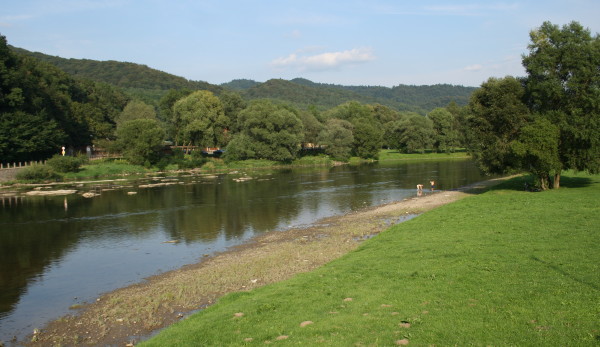Sianik
Sianik or Sianok [Сянік; Sjanik or Сянок; Sjanok] (Polish: Sanok). Map: IV-3. A city (1998 pop 41,600) on the Sian River and a county center in Subcarpathian voivodeship, Poland. It is first mentioned, as a fortified town of Kyivan Rus’, in the Hypatian Chronicle under the year 1150. Later it was part of Peremyshl principality and then the Principality of Galicia-Volhynia. It was granted the rights of Magdeburg law by Yurii II Boleslav in 1339, and developed into an important trade center. In the mid-14th century Sianik was annexed by Poland and turned into the capital of Sianik land in Rus’ voivodeship. In 1550, during the course of Catholic persecution of the Orthodox, Saint Demetrius's Church was closed. Toward the end of the 16th century the town declined. With the partition of Poland in 1772, it was transferred to Austria, and became a county center of the Galician crownland. In the second half of the 19th century the town grew as a railway link and attracted industry. Its population increased from 2,500 at mid-century to 5,100 in 1880, 9,000 in 1900, and 12,100 in 1921. At the same time Ukrainian residents of Sianik were subjected to strong Polonization pressures. From 1880 to 1900 the Ukrainian population fell from 18 percent to 13.5 percent. In the interwar period the town remained a center of Ukrainian cultural life in the eastern Lemko region. In 1930 the Lemkivshchyna Museum was established there, and in 1936 Sianik was chosen as the seat of the Lemko Apostolic Administration. At the beginning of 1939, 1,800 (11.5 percent) of the town's residents were Ukrainian, 8,700 (56 percent) were Polish, and 5,100 (32.5 percent) were Jewish. Under the German occupation (1939–44) the Ukrainian population increased to 3,000, and Ukrainian cultural life revived. A Ukrainian secondary school was set up, and the Ukrainian Relief Committee, under P. Bilaniuk, was active. In 1946–7, during Operation Wisła, Ukrainians were deported from the town, and all signs of community life died out.
Today Sianik is an industrial city. Its regional museum contains many Ukrainian monuments, including some icons from the former Lemkivshchyna Museum. The open-air Museum of Folk Architecture (est 1958) contains many exhibits by Boikos, Lemkos, and other Ukrainian folk artists. Its periodical (published from 1969) often deals with Ukrainian folklore. The city's chief architectural monuments are the castle (built in 1523–48, renovated in 1672–7 and 1952–3), the Franciscan church and monastery (17th and 19th centuries), and a church in the Classicist style (1784–9). An Orthodox parish and a branch of the Ukrainian Social and Cultural Society have been set up.
BIBLIOGRAPHY
Tarnovych, Iu. Kniazhe misto Sianik (Cracow 1941)
Volodymyr Kubijovyč
[This article originally appeared in the Encyclopedia of Ukraine, vol. 4 (1993).]
 city center.jpg)
 Holy Trinity Ukrainian Catholic Church.jpg)
.jpg)
 Museum of Folk Architecture.jpg)
 (aerial view).jpg)
